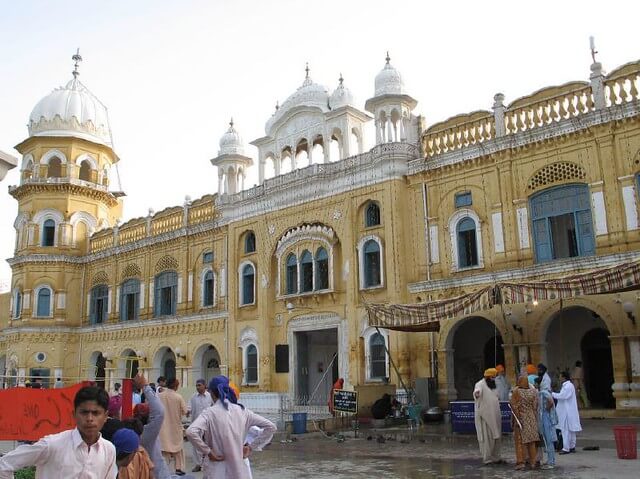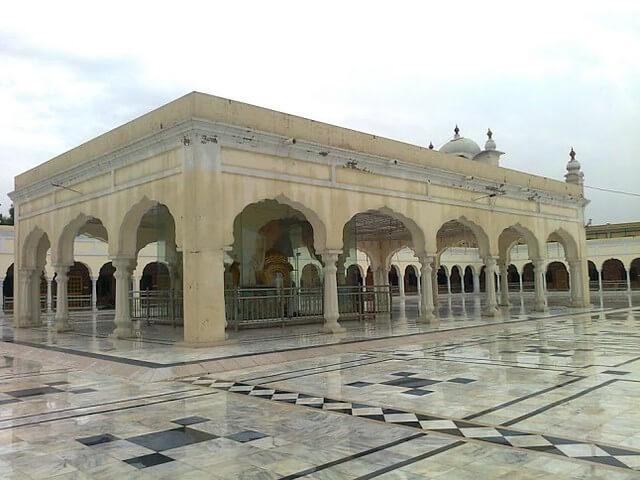Discover the History and Importance of Nankana Sahib Gurdwara Pakistan
Nankana Sahib Gurdwara Pakistan, Nankana Sahib is the city and capital of the Nankana Sahib District in Pakistan’s Punjab province. It is named after Guru Nanak, the first Guru of the Sikhs, who was born in the city and started preaching there. Today, it is a city of great historical and religious significance, as well as a famous pilgrimage destination for Sikhs from all over the world.
It is located around 80 kilometers (50 miles) west of Lahore and 75 kilometers (47 miles) east of Faisalabad. Rai Bhoi created the settlement, which became known as Rai-Bhoi-Di-Talwandi. His great-grandson Rai Bular Bhatti christened it ‘Nankana Sahib’ after Guru Nanak’s birth. The Gurdwara Nankana Sahib, built approximately 1600 CE, was reconstructed in 1819-20 CE by Gian-Punjab Maharaja Jassa Singh Ramgarhia, the Sikh Conference of Punjab, Jammu and Kashmir, Peshawar, Kangra, and Hazara.
On February 20, 1921, during the Akali Movement, Narain Das, the Udasimahant (clergy) of Nankana Sahib Gurdwara, ordered his troops to open fire on Akali demonstrators, resulting in the Nankana Massacre. The fire was highly denounced, and a movement was initiated to reclaim ownership of the ancient Janam Asthan Gurdwara for Sikhs. In the 1930s and 1940s, the Sikhs expanded their structures and architectural designs.
Before independence, migration between India and Pakistan was ongoing. By 1900, Western Punjab was largely Muslim, and it backed the Muslim League and the Pakistan Movement. Following independence in August 1947, minority Sikhs and Hindus moved to India, while Muslim refugees from India settled in Western Punjab and throughout Pakistan.
The region around Nankana Sahib was once a tehsil in Sheikhupura District. Nankana Sahib was elevated to the rank of a district by the province administration in May 2005 as a means of supporting local development.
The Dawn of Sikhism at Nankana Sahib
Birth of Guru Nanak Dev Ji: The year was 1469, and in the village of Rai Bhoi di Talwandi, the world witnessed the advent of a luminary who would forever change the spiritual landscape of South Asia. Guru Nanak Dev Ji’s teachings of oneness, compassion, and social equality would spread far beyond Punjab’s borders.
The Birth of the Gurdwara: Rai Bular Bhatti, a local Muslim lord, understood the importance of Guru Nanak’s teachings and built a humble Gurdwara on the spot of his birth. Over the ages, the Gurdwara underwent several renovations to suit the increasing number of pilgrims.
Architecture and Layout of Nankana Sahib Gurdwara
Architectural Marvel: The Nankana Sahib Gurdwara complex, built in 1921 under Maharaja Bhupinder Singh’s patronage, has a unique blend of Islamic and Sikh architectural elements. The dome-shaped edifice, embellished with elaborate marble work and majestic archways, reflects the region’s rich cultural legacy.
Sarovar and Langar: The peaceful body of water within the Gurdwara complex represents the divine source of life and spirituality. The Langar, a community kitchen that provides free meals to all visitors, represents Sikhism’s principles of equality and social peace.
The significance of Nankana Sahib Gurdwara in Sikhism
Spiritual Pilgrimage: Every year, Sikhs worldwide gather at Nankana Sahib Gurdwara to commemorate Guru Nanak Dev Ji’s Gurpurab (birth anniversary). The air is filled with devotional music and fervent prayers as devotees attempt to connect with their Guru’s spiritual heritage.
Cultural and Educational Hub: The Gurdwara is not just a religious shrine, but also a thriving cultural and educational center. Artisans, poets, musicians, and intellectuals from many backgrounds gather to honor Punjab’s rich legacy and participate in intellectual conversation.
The Sikh Community in Pakistan
Upholding Interfaith Harmony: Pakistan’s Sikh community prioritizes interfaith harmony, as seen by the existence of Gurdwaras such as Nankana Sahib. The Sikh community actively participates in Pakistan’s cultural mosaic, helping to shape its heterogeneous character.
Preservation and Promotion: The Pakistani government, in partnership with local and international groups, has launched preservation and restoration initiatives to protect Nankana Sahib Gurdwara’s architectural and cultural legacy.
Modern Relevance of the Nankana Sahib Gurdwara
Promoting Religious Tourism: The Nankana Sahib Gurdwara attracts religious visitors, history aficionados, and pilgrims from all over the world. Its calm atmosphere and historical importance provide tourists with a unique insight into Sikh faith and tradition.
Educational Initiatives: Gurdwaras play an important role in spreading information about Sikhism and its teachings. Educational events, workshops, and seminars are planned to teach visitors about Sikhism’s ideology, traditions, and contributions to mankind.
Attractions Offered By Nankana Sahib
Nankana Sahib Gurdwara Pakistan has several attractions for visitors.
Majestic Building of Nankana Sahib
When you arrive, your attention will be drawn to the majestic Nankana Sahib building. The Majestic Building was built in 1886 by the Sikh Maharaja Ranjit Singh.
It is a vast complex that includes a temple, a library, and a museum. The edifice is an important part of the city’s history and culture, attracting visitors from all over the world.
Nankana Sahib
Thousands of visitors visit the Majestic Building each year to honor the city’s Sikh history. The edifice represents Pakistan’s vast cultural variety and the Sikh community’s religious tolerance.
Main Square
The main area in Nankana Sahib is a lovely open space surrounded by pink sandstone structures. In the heart of the square is a beautiful marble gurdwara, or Sikh temple. Two beautiful parks flank the Gurdwara, which has white walls covered with elaborate gold lettering. This prominent area serves as a striking reminder of their religion’s rich heritage.
Holy Water Pool (Saroor Sahib)
Nankana Sahib is home to several religious places, including the Saroor Sahib, or religious Water Pool. The pool is located within the Nankana Sahib Gurdwara complex and is said to have been created by Guru Nanak Dev Ji. The pool’s water is thought to have medicinal qualities, and drinking from it can cure ailments.
Every year, thousands of Sikhs and pilgrims from all over the world visit Nankana Sahib to bathe in the Saroor Sahib and drink its holy water.
Palki Sahib Nankana Sahib
One of Nankana Sahib’s most important locations is the Palki Sahib, a lovely wooden building that contains a precious relic of Guru Nanak. The Palki Sahib is a sacred site for Sikhs, and it is customary for pilgrims to circumambulate the building three times before paying their respects.
For many Sikhs, visiting Nankana Sahib is an unforgettable experience, and the Palki Sahib is an integral component of that journey.
Mandap
One of Nankana Sahib’s most prominent attractions is the Mandap, a massive covered structure created in honor of Guru Nanak Dev Ji. The Mandap is beautifully ornamented with Sikh art, and its central location makes it an ideal spot for pilgrims to stop and worship. In addition to its religious importance, the Mandap is a popular venue for weddings and other events.
Conclusion
Nankana Sahib Gurdwara’s impact extends beyond religious and geographical bounds. It is a place of spiritual reflection, a symbol of perseverance, and a light of hope. As the world evolves, Guru Nanak Dev Ji’s timeless teachings continue to inspire and guide us down the road of compassion, equality, and global brotherhood.



